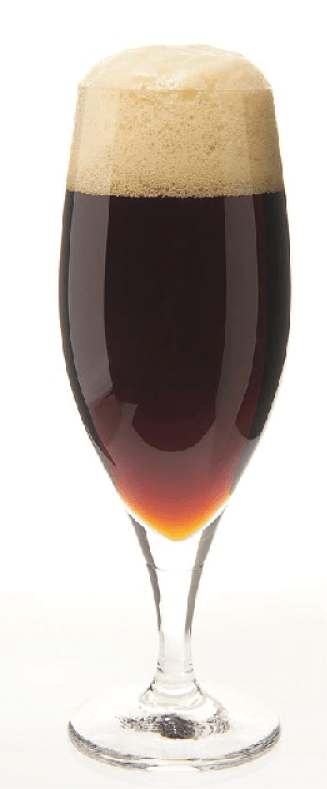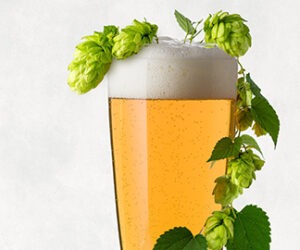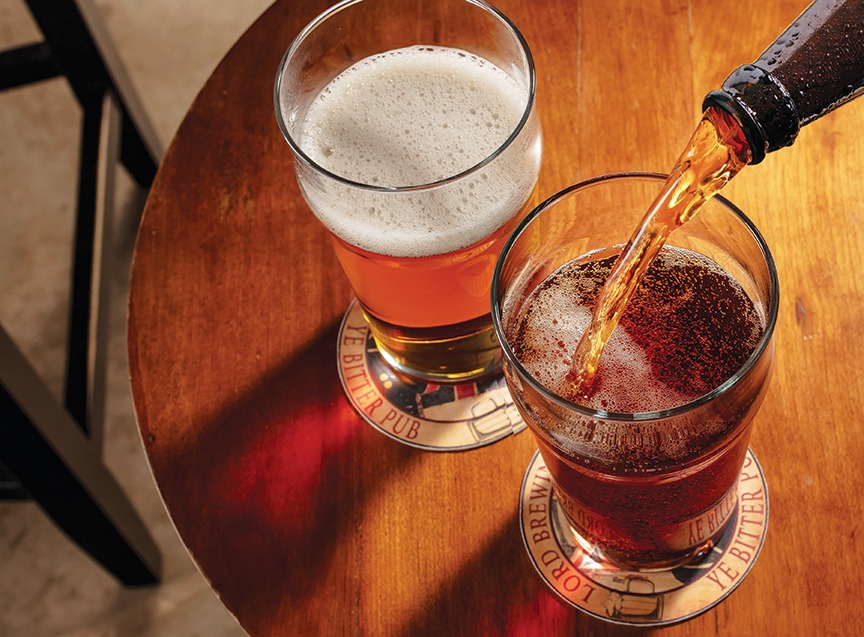Doppelbock
When new homebrewers come into the hobby, it seems that they often focus on pale ale, IPA and stout. I think I was really lucky when I started homebrewing, because many of the homebrewers I met had already moved on from those common styles. That early exposure really helped my beer knowledge blossom. For example, bock beers were common around our homebrew community. I remember being particularly pleased with the bock beers of my friends Steve Christian, Roger Rehmke and Rich Dickson. They all made bock beers that were rich and flavorful, but not so heavy that you could not down a liter with ease.
Doppelbock is a smooth, rich lager beer with a big malt character. It can be either pale or dark in color, as it is a bigger version of either a bock or Maibock. All bock beers have a lot of bready and toasty malt character, but that does not mean they are overly sweet. A doppelbock should be well attenuated, but the low hopping rate results in a balance toward the sweet side. A doppelbock should always be brilliantly clear and can range from deep golden to dark brown. Any alcohol should be smooth and slightly warming, never hot or solvent-like. The fermentation character is clean. While the beer should have minimal esters, some examples will exhibit, through a combination of malts and alcohol, a fruity, grape or dark fruit character.
A great doppelbock recipe is relatively simple, but many brewers try to make it far too big or more complex than needed in an effort to increase malt character. Keep in mind that all German beers are easy-drinking and doppelbock should be no exception. The best way to achieve that great German malt character is with high quality, full-flavored base malts and excellent fermentation practices. I would never attempt to make a doppelbock without using continental Pilsner and Munich malts. You can use other base malts, but the light, grainy and bready taste of high quality Pilsner and Munich malt is right on target for this style. The bulk of the grist should be Munich malt, anywhere from 50 to 70% is good, depending on the character and color of the Munich malt you source. A portion of caramel malt is acceptable, and I like the rich malty sweetness of caramel Munich malts. You can experiment with different color levels and percentages, but approximately 10% of a mid-color (40 to 80 °L) caramel is plenty. Use a high quality continental Pilsner malt for the remainder of the grist. You should be able to make an excellent example of the style with just those three malts, but if you must, you can add other malts, such as head and body forming dextrin malts or color enhancing malts. Avoid overloading the beer with too many extra specialty malts. A common problem is making the beer too melanoidin rich in an attempt to make a beer with a lot of malt character. While you want a lot of those rich melanoidin flavors, too much can make the beer taste meaty or brothy.
Extract brewers will need to use a Munich extract or do a partial mash with Munich malt. Most Munich malt extract is a blend of Munich and Pilsner (or other pale malts) in different percentages. I would try to get an extract made with as much Munich malt as possible, but always let flavor and freshness be your guide. That said, most Munich extract blends are close enough for a decent doppelbock without any adjustment. The only supplier of 100% Munich extract I am aware of is Weyermann. If you can get 100% Munich extract, then you can blend it with a Pilsner malt or pale malt extract.
I like to avoid any work that I do not feel improves a beer, so I prefer a single infusion mash. Perhaps, historically, a brewer would use a decoction mash when brewing most German-style beers, but I find that high quality continental malts, a single infusion mash, and excellent fermentation practices will produce beer every bit as good as the best commercial examples. It is far more important to invest time and effort in fermentation, sanitation, and post fermentation handling than on decoction. If you have ensured that all of those other aspects of your process are flawless, then decoction might be something of interest. For a single infusion mash, target a mash temperature range of 152 to 156 °F (67 to 69 °C).
At most, hop character is just a background note in doppelbock. This is a beer about rich malt character and a fine example requires no hop character. If you do like a touch of hop character, keep it subtle and use only floral or spicy type hops. I prefer German grown Hallertau hops, but other German grown hops, such as Tettnang, Perle or Tradition, work well also. These hops, when grown outside of Germany, can still work well but you should check with your supplier first if you are not sure how closely they match the German grown hops. If you cannot get any of those hops, try to select hops with that same flowery or spicy noble hop character. You do not want to use anything fruity or citrusy. Some decent substitutions are Liberty and Mt. Hood. You can also try Crystal, Ultra and Vanguard. The big picture is that you want very low hop character and just a balancing bitterness, with both complementing and integrating with the malt. The balance of bittering versus malt sweetness should be even or slightly on the sweet side. The bitterness to starting gravity ratio (IBU divided by the decimal portion of the specific gravity) ranges from 0.2 to 0.4, but I like to target around 0.3. Restrict your late hops to small additions. In general, 0.25 to 0.5 oz (7 to 14 g) in the last 20 to 30 minutes of the boil for a 5 gallon (19 L) batch is the most you should use.
You can ferment doppelbock with almost any lager yeast, though my favorites are White Labs WLP833 (German Bock Lager) and Wyeast 2206 (Bavarian Lager). You will find that different lager yeast strains will emphasize different aspects of the beer. Some will emphasize malt character, some will emphasize hop character, and some will be in-between, but all can produce an excellent bock with proper fermentation. It is important to note that the sweetness present in doppelbock is more from a relatively low hop bitterness, not from incomplete fermentation.
While this style is higher in alcohol than most lagers, the beer should never be hot or solvent-like. A gentle warming when you drink the beer is what you want. Anything more is a flaw. You will run into judges that do not understand this point and seem to think doppelbock should taste like rocket fuel. Do not fall into that trap. Instead, make efforts to try to educate those that think hot alcohols are good to drink. Proper control of fermentation temperature, a proper pitch of healthy yeast, and adequate nutrients is all it takes to avoid that hot alcohol problem.
When making lagers, I like to chill the wort down to 44 °F (7 °C), oxygenate and then pitch my yeast. I let the beer slowly warm over the first 36 hours to 50 °F (10 °C) and then I hold this temperature for the remainder of fermentation. If fermentation seems sluggish at all after the first 24 hours, I am not afraid to raise the temperature a couple degrees more. The idea is to reduce the diacetyl precursor alpha-acetolactate, which the yeast creates during the early phase of fermentation. Once the growth phase of fermentation is complete, it is important that fermentation be as vigorous as possible. It may never be as robust as fermentation at ale temperatures, but it is important to have enough activity to blow off aromatic sulfurs and other unpleasant compounds. Vigorous yeast activity at the end of fermentation also improves reduction of compounds such as diacetyl and acetaldehyde. Starting fermentation colder only works well if you are pitching enough clean, healthy yeast at the start. If not, you will need to start warmer (perhaps 55 °F/13 °C) to encourage more yeast growth. Even if you start fermentation warmer, you can still raise the temperature toward the latter part of fermentation.
Since diacetyl reduction is slower at colder temperatures, a cold fermented lager may require a diacetyl rest. To perform a diacetyl rest, simply raise the temperature into the 65 to 68 °F (18 to 20 °C) range for a two-day period near the end of the fermentation. While you can do a diacetyl rest after the fermentation reaches terminal gravity, a good time for a diacetyl rest is when fermentation is 2 to 5 specific gravity points (0.5–1 °P) prior to reaching terminal gravity. Brewers ask how they should know when fermentation has reached that stage. My advice is to raise the fermentation temperature for a diacetyl rest as soon as you see fermentation activity significantly slowing. It will not hurt the beer and it should help the yeast reach complete attenuation as well.
It seems that every beer style improves with some period of cold conditioning and this style is no exception. Traditional lager conditioning utilizes a slow temperature reduction before fermentation reaches terminal gravity. The purpose of the slow cooling rate is to avoid sending the yeast into dormancy. After a few days, the beer reaches a temperature close to 40 °F (4 °C) and the brewer transfers the beer into lagering tanks. If you want to use this technique, you will need precise temperature control so that fermentation slowly continues and the yeast remains active. Rapidly chilling the beer near the end of fermentation can cause yeast to excrete a greater amount of ester compounds instead of retaining them.
Personally, I prefer to wait until fermentation is complete, including any steps such as a diacetyl rest, before lowering the beer temperature. The yeast is far more active and able to reduce fermentation byproducts at higher temperatures. Once I am certain the yeast have completed every job needed, I use a period of cold storage near freezing. This time in storage allows very fine particulates to settle out and the beer flavors to mature. In any case, great lagers take time, so do not rush things.
by the numbers
OG: 1.072–1.112 (17.5–26.3 °P)
FG: 1.016–1.024 (4.1–6.1 °P)
SRM: 6–25
IBU: 16–26
ABV: 7–10%
Doppelbock
(5 gallons/19 L, all-grain)
OG = 1.086 (20.6 °P)
FG = 1.020 (5.2 °P)
IBU = 24 SRM = 19 ABV = 8.7%
Ingredients
3.8 lbs. (1.7 kg) Best Malz or similar continental Pilsner malt 2 °L
13.4 lbs. (6.1 kg) Best Malz Munich malt 8 °L
1.8 lbs. (800 g) Weyermann CaraMunich® III malt 57 °L
5.2 AAU Hallertau hops (1.3 oz./37 g at 4.0% alpha acids) (60 min.)
1 AAU Hallertau hops (0.25 oz./7 g at 4.0% alpha acids) (30 min.) (optional)
White Labs WLP833 (German Bock Lager) or Wyeast 2206 (Bavarian Lager) yeast
Step by Step
Mill the grains and dough-in targeting a mash of around 1.5 quarts of water to 1 pound of grain (a liquor-to-grist ratio of about 3:1 by weight) and a temperature of 155 °F (68 °C). Hold the mash at 155 °F (68 °C) until enzymatic conversion is complete. Infuse the mash with near boiling water while stirring or with a recirculating mash system raise the temperature to mash out at 168 °F (76 °C). Sparge slowly with 170 °F (77 °C) water, collecting wort until the pre-boil kettle volume is around 6.5 gallons (25 L) and the gravity is 1.066 (16.2 °P).
The total wort boil time is 90 minutes, which helps reduce the S-Methyl Methionine (SMM) present in the lightly kilned Pilsner malt and results in less Dimethyl Sulfide (DMS) in the finished beer. Add the first hop addition with 60 minutes remaining in the boil. Add the second hop addition 30 minutes later. Add Irish moss or other kettle finings with 15 minutes left in the boil. Chill the wort to 50 °F (10 °C) and aerate thoroughly. The proper pitch rate is nearly 600 billion cells (30 million cells/mL), which is 6 packages of liquid yeast or one package of liquid yeast in a 22-liter starter. That would be a starter equal to a batch of beer, so consider making a smaller beer first and repitching the yeast from that beer into this one.
Ferment around 50 °F (10 °C) until the yeast drops clear. With healthy yeast, fermentation should be complete in two weeks or less, but do not rush it. Cold fermented lagers take longer to ferment than ales or lagers fermented at warmer temperatures. If desired, perform a diacetyl rest during the last few days of active fermentation. Rack to a keg and force carbonate or rack to a bottling bucket, add priming sugar, and bottle. Target a carbonation level of 2 to 2.5 volumes. A month or more of cold conditioning at near freezing temperatures will improve the beer. Serve at 43 to 46 °F (6 to 8 °C).
Doppelbock
(5 gallons/19 L, extract only)
OG = 1.085 (20.4 °P)
FG = 1.020 (5.2 °P)
IBU = 24 SRM = 17 ABV = 8.6%
Ingredients
11.9 lbs. (5.4 kg) Munich Blend liquid malt extract 6 °L
1.8 lbs. (800 g) Weyermann CaraMunich® III malt 57 °L
5.2 AAU Hallertau hops (1.3 oz./37 g at 4.0% alpha acids) (60 min.)
1 AAU Hallertau hops (0.25 oz./7 g at 4.0% alpha acids) (30 min.) (optional)
White Labs WLP833 (German Bock Lager) or Wyeast 2206 (Bavarian Lager) yeast
Step by Step
I have used a number of Munich blend extracts to brew doppelbock. While most of them have less Munich malt in them than I prefer for this style, they will still do an admirable job of brewing bock. If you cannot get fresh liquid malt extract, use an appropriate amount of dried extract instead. Using fresh extract is very important to this style.
Add enough water to the malt extract to make a pre-boil volume of 5.9 gallons (22.3 L) and the gravity is 1.072 (17.5 °P). Stir thoroughly to help dissolve the extract and bring to a boil.
Once the wort is boiling, add the bittering hops. The total wort boil time is one hour after adding the first hops. Add the second hop addition 30 minutes later. Add Irish moss or other kettle finings with 15 minutes left in the boil. Chill the wort to 50 °F (10 °C) and aerate thoroughly. The proper pitch rate is nearly 600 billion cells (30 million cells/mL), which is 6 packages of liquid yeast or one package of liquid yeast in a 22-liter starter. That would be a starter equal to a batch of beer, so consider making a smaller beer first and repitching the yeast from that beer into this one.
Ferment around 50 °F (10 °C) until the yeast drops clear. With healthy yeast, fermentation should be complete in two weeks or less, but do not rush it. Cold fermented lagers take longer to ferment than ales or lagers fermented at warmer temperatures. If desired, perform a diacetyl rest during the last few days of active fermentation. Rack to a keg and force carbonate or rack to a bottling bucket, add priming sugar, and bottle. Target a carbonation level of 2 to 2.5 volumes. A month or more of cold conditioning at near freezing temperatures will improve the beer. Serve at 43 to 46 °F (6 to 8 °C).




